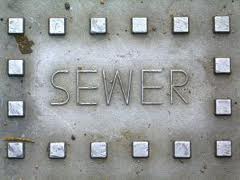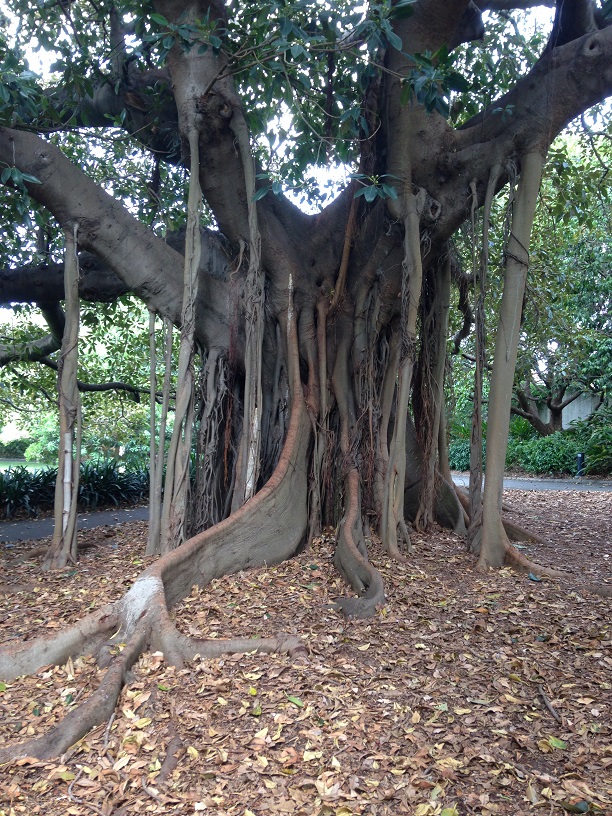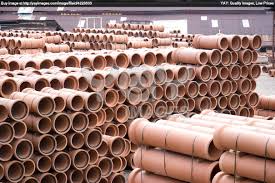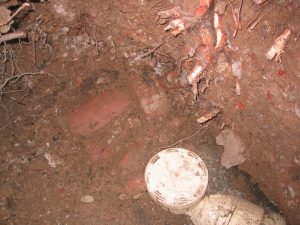Condensation attracts tree roots to sewer pipes
Did you know tree roots are attracted to condensation on the inside of drain pipes?
Trees are naturally drawn to moisture and nutrients, and condensation can provide a source of both. The roots of a tree can detect the presence of moisture inside a pipe and grow towards it. As the roots grow, they can cause blockages or damage to the pipes. This can be more prevalent in areas with high humidity.
It’s also worth noting that tree roots are also attracted to other sources of moisture such as leaks, cracks or joints in the pipe and then the waste material inside the pipe. Tree roots will seek the nutrients found in the waste material in the sewer pipes.
It’s important to note that tree roots can cause damage to pipes no matter where the pipes are located, whether it’s near or far from the tree.
We have seen instances where tree roots will grow above the ground to get into sewer pipes that have been laid above ground under a house.
If you’ve had a blocked drain caused by tree roots, its definitely worth having your plumber regularly checking your pipes and addressing any issues promptly to stop blockages and prevent further damage caused by tree roots.

How do Tree roots grow?
Tree roots grow in different ways depending on the species of tree.
Some trees have a taproot system, where the main root grows straight down and branches off into smaller roots.
Other trees have a fibrous root system, where many small roots grow out in all directions from the base of the tree.
Roots also grow towards moisture and nutrients, so they may grow deeper in dry or nutrient-poor soil and closer to the surface in moist or nutrient-rich soil.
Additionally, tree roots can grow laterally, horizontally or vertically depending on the species of the tree and the soil conditions.
How do you Stop Tree roots in Drains?
Its called Vaporooter. Click here to find out more.
Do summer rains make stronger tree root growth?
Summer rain can encourage stronger tree root growth. Trees need water to survive, and during the summer months, when the weather is hot and dry, adequate water is essential for the tree’s survival. Rainfall during the summer can provide the necessary water for the tree’s roots to absorb and grow.
Additionally, summer rain can also help to loosen compacted soil, allowing the roots to penetrate deeper and spread out more easily. This can lead to stronger, healthier root systems that are better able to support the tree.
However, it’s worth noting that heavy rainfall can also cause soil erosion and can lead to waterlogged soil, which can suffocate tree roots and inhibit their growth. It’s also good to note that, while water is important for tree growth, too much water can also be harmful.
It’s important to note that while water is important, it’s not the only factor that affects tree growth. Other factors like temperature, sunlight, soil nutrients, and pests also play a significant role. A well-balanced environment with adequate water and other factors is essential for a tree’s healthy growth.
Whether we have wet or dry summers, the nutrients or natural fertiliser available in sewer pipes makes them a magnet for the searching tree roots of many species. Our experience has seen that if trees can “drink” the abundant water available during summer rains, the tree roots will swell and cause more blocked drains.

Tree Roots are a pain in the drain!
Tree Roots never stop growing in your sewer pipes.
Cut them out and they just grow back!
Depending on the tree, it can take up to 3, 6 or 12 months, or sometimes more, but they do grow back…Like a time bomb ticking away.
When you get a blocked drain and have your plumber cut tree roots from your sewer pipes, every 3, 6 or 12 months, the cutting action, whether by electric eel or high-pressure water damages the pipes.
The cutting action is like pruning. Any gardener will tell you that pruning will make the tree grow stronger, and thats what happens with your tree roots.
You cut the tree roots, and they grow back Thicker and Stronger.
You know all the symptoms.
The smell, the gurgling, ankle deep shower water, you lift the lid on the loo, AND IT’S STILL THERE!
Now your plumber is a likable bloke.
His number is on your auto dial. He knows where the door keys are, and the dog just wags his tail when he shows up.
He’s put his kids through private school because the tree out the front of your home keeps growing in your sewer, blocking your drains
There must be another way to Stop Tree Roots in Drains
There is. It’s called Vaporooter!
When you’re ready to talk about it, Call us on 1800 637 600
Who can Help me Stop Tree Roots in Drains?
Vaporooter will Stop Tree Roots in your Drains!
It’s not a DIY process. Vaporooter must be applied by a Certified Applicator to ensure:
# The pipeline is suitable
# You have the right access to the pipes
# The job is done properly
# You get a Guarantee
If you have any questions, call me on 1800 637 600.
Vaporooter – There are some setup costs
G’day! Its Dave Conroy. I’m here today to talk about Vaporooter.
There are some set-up costs if you are considering putting Vaporooter down your sewer pipes if you’ve got repeat blockages caused by tree roots.
The setup costs are a one off thing and, what they include is putting a drain camera through your pipes to survey exactly what is going on inside your pipes to determine if your pipes are actually suitable for a Vaporooter application. 9/10 times they are!
Now, the most common question people ask me is “Does the product work?” Yes, It does!
We’re actually applying Vaporooter at this property in Vaucluse in Sydney’s eastern suburbs this morning. This is a client who has had it applied for five years in a row.
So, to sumarise:
Yes, there some setup costs.
Yes, It does work.
Yes, you need to have it applied annually.
If you’ve got any questions, through Vaporooter Australia, please contact me on 1800 637 600
Or go to our website: VaporooterAustralia.com.au
Vaporooter or pipe re-lining – A cost comparison
Hello, its Dave Conroy here and I’m here to talk about my favourite subject, stopping tree roots in sewer pipes.
And in particular with Vaporooter!
Now, one of the most common questions that is asked of me is “Should I re-line my pipes or Should I use Vaporooter?”
Simply put, relining is a great process in the right place. To re-line a single metre, one metre of pipeline here in Sydney will cost you about one thousand dollars. For that amount of money, you could treat a 30 metre section of pipeline! So, economically, Vaporooter is a great option.
To reline 30 metres it’s about 30 grand.
To treat 30 metres with Vaporooter will cost you about $1000.00. It will keep tree roots away and give you an opportunity to work out what to do with your pipes in the long term.
If you have any questions about whether you should re-line or apply Vaporooter to your home,
Call me on 1800 637 600 or go to www.VaporooterAustralia.com.au
Plumbing Terms
You’re going to want to be prepared for what your plumber has to say about the tree roots blocking your pipes. Maybe you’ve already talked to your plumber but you didn’t completely understand everything he said.
In any case, here’s a list of terms that may be basic to your plumber, but not so basic to you:
Backfill: Soil used to refill a trench that was dug up to excavate pipes.
Bedding: Material laid under a pipe that supports it and keeps the pipe from shifting in the soil.
Boundary Trap: A point of disconnection between your property/properties sewer and the local authority’s main. All your sanitary plumbing runs to this trap. It has a water seal to stop the smell from the sewer coming back up the line.
Cement Mortar Joint: A socket joint or pipe bend made out of cement.
Choke: A blocked drain.
Clearout: See I.O.
Conduit: A fancier word for pipe.
Defect: Decaying material, abnormality or obstruction in pipes that affects your plumbing.
Sanitary Drain: The plumbing (within your property line) that carries waste water away from your home or business. This type of drain includes any fitting or pipe that’s outside of the building.
House Drain: Plumbing within your sanitary drain system that carries waste water from sinks, toilets, equipment and tubs. This type of drain includes any plumbing that’s inside of the building.
Drainage Diagram: A map or plan of the approved sewer lines throughout your property; available from your local water authority, usually attached to a property ”contract of sale”.
Drainoscopy: A drainoscopy is the process of surveying your drainage pipelines with a high tech purpose-built camera. It really is the only way to see what is going on underground. A drainoscopy will show pipes, pipe joints, tree root penetrations, damage or even collapsed sections of pipe. A drainoscopy can be recorded and forwarded to you via email.
Helio: Plumbers over the age of 30 refer to this. See Drainage Diagram.
Infiltration: Unintended ground or storm water that makes it’s way into the sanitary/sewer drainage system, usually through cracks in pipes or joints, or tree root penetrations.
Installation: The creation of your network of pipes and fixtures or just your network of pipes and fixtures.
I.O. Inspection opening; a point of access into your house drains and branches.
Main: Usually owned and maintained by the local “Water authority”.
Pulling: Manually removing pipe obstruction by pulling a disk through the plumbing.
Rodding: Manually removing pipe obstruction using a system of jointed rods, like an electric eel.
Root Foam: A chemical foam mixture applied to pipes after mechanic root removal to prohibit future plant intrusion and reinforce pipes.
Root Penetration: Tree roots growing into plumbing, pipes, drains and sewers.
Rubber Ring Joint: A type of pipe joint seal that’s made out of chemically treated rubber circa; 1970-85
Sewer Main: The publicly owned pipes that carry waste water away from your property.
Sludge: Sort of the opposite of scum, this is pipe obstruction that sinks to the bottom of plumbing.
Spigot or Socket Joint: The male end of a pipe.
Sullage: Household waste water; specifically from sinks, kitchens and laundries.
Surcharge: Pipe or drain overflow cause by a combination of plumbing blockages and an abundance of rain. It could be from the main.
Surcharge Gully: An outside drain which may have a tap over. It is lower than your lowest floor drain, so that surcharge occurs here, not inside your home. It also has a water seal.
Blocked Drain Solutions
STOP TREE ROOTS IN PIPES
- Substantial damage can be caused to your sewer system by the invasion of tree roots into the drain pipes which have been cracked as a result of natural settling, age or wear. Trees are good at finding water and their roots can travel a hundred feet to get to the nourishment they need.
- Tree roots in your sewer line can be a constant problem that you can do without. Blocked drains can be one of the most frustrating and inconvenient, not to mention one of the most costly problems you can have at your home. So it is important to remove tree roots from sewer lines to ensure the free flow of liquids through your sewer system.
- You have to understand the tree’s root system, how it grows, before you start cutting tree roots. That way you can significantly reduce the harm to the tree, and possibly to you and your property.
- Be aware that by cutting the roots the tree will react by producing a large number of smaller roots. This means the tree roots grow back and may cause future issues.
- Drains when clogged, tend to be the most difficult problem of all the household emergencies. There is often no warning before a blocked drain occurs and you are faced with a stinky home, flooded floors and power knocked out as a result.
- No matter how stressed you are or how chaotic things have become, a blocked pipe isn’t a disaster; it’s simply just another problem that needs fixing! The first thing is try to locate the problem and then you can decide whether it’s fixable or whether you’ll need to call in a professional.
- Underground sewer pipes are prone to attack by tree roots. The small roots work their way through the pipe connections and, if given sufficient time, they will effectively clog the system. Cleaning a sewer pipe is an unpleasant task at best, and if you continue to experience a clogged sewer pipe you need to take the necessary steps to have the problem dealt with.
- Proper drain cleaning for sewer pipes that have tree root problems is not, luckily, a very difficult job using today’s plumbing technology to remove roots in pipe. You can call in a professional to handle the situation for you.
- The main cause of sewer backups is the invasive nature of tree roots. Seen as ‘An Unseen Predator’ these tree roots will penetrate not only soil, but sewer pipes as well. You therefore have to look into methods of safe tree root removal that will stop roots re-entering your pipes and will save yourself the expense of having to keep clearing and maintaining them.
- There are some products that you can use which claim to kill tree roots in sewage lines, but they quite often don’t take care of the problem adequately and you wind up with worse problems that before. Therefore you will need to seek professional guidance for finding an environmentally safe process for removal that will do the job for you.
Tree roots don’t like wet feet
Even though tree roots get into pipes seeking water, they don’t like to be in the water all the time.
Excavated soil allows the fine tree roots to move along the top of and into the pipe joints and then down into the water flow.
In permanently water charged ground, tree roots rarely appear in the sewer because they don’t like to be continually immersed in water.
Tree roots enter pipes through the joints
Clay sewer pipes provide a great opportunity for tree roots to get into your pipeline.
These pipes are usually 2-3 foot or 600-900mm long and there could be up to 50 individual pipes, bends and junctions in a 30 metre (100ft.) pipeline.
That means there are at least 50 pipe joints for a tree to get its roots into your sewer pipes and helps explain why you can have multiple blockages in your pipes.
To excavate and repair or reline where the tree roots are getting in today doesn’t mean the tree roots won’t get in a little further downstream.
Vaporooter treats every joint in the pipeline.

Tree roots get in through the joints
Why trees choose sewer over stormwater pipes
Trees are more likely to grow into sewer pipes than stormwater pipes.
Every day we use our plumbing sending that water and fertiliser combination along the pipeline for the trees and their root systems to drink their fill. BUT, stormwater pipes only carry water when it rains, which in this country is fairly unreliable.
If I was a tree and had a choice of putting my roots into a sewer pipe or a stormwater pipe, I would choose the sewer pipes because every day, as regular as clockwork, I will be fed and watered. If I chose the stormwater pipes, I may die of thirst!
Tree roots grow through pipe joints.
Tree roots usually enter your pipe line through the pipe joints.
Did you know each clay sewer pipe is usually 2-3 foot long? That’s 600-900mm each.
So, in a pipe line 100 feet in length (30 metres), there could be up to 50 individual pipes with bends and junctions.

That means there are at least 50 different places for tree roots to get into your sewer pipes.
That’s a lot of opportunity for tree roots searching for moisture in our hot Australian climate where rainfall is unpredictable.
If you’re considering pipe relining, root cutting or a pipe renewal as options for keeping the roots at bay, remember, the tree roots can just move down to the next pipe joint that hasn’t been protected.
Tree roots in drains start out small
Do you know how small tree roots are when they enter your sewer drains?
Believe it or not, the tree roots that enter your drains through the small cracks in the pipe joints are finer than the hairs on your head or the purest Australian wool.
Once they find their way into the cracks and pipe joints they multiply.
How tree roots get into pipes #3

Tree roots grow into cracks in the joints of sewer pipes that may have been there even before the pipes were used.
Hard to believe but envisage this.
Your friendly plumber has dug a trench, laid the new earthenware pipes, cemented all the joints, then proceeded to back fill the trench.
The very process of backfilling the trench is enough to put pressure and fine cracks in the cement joints.
That is just enough to let the tree roots know that warm condensation is nearby.


